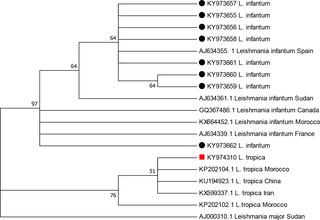PLOS Neglected Tropical Diseases ( IF 3.4 ) Pub Date : 2018-03-02 , DOI: 10.1371/journal.pntd.0006315 Idris Mhaidi , Sofia El Kacem , Mouad Ait Kbaich , Adil El Hamouchi , M’hammed Sarih , Khadija Akarid , Meryem Lemrani

|
Background
Cutaneous leishmaniasis (CL) is an infectious disease caused by various species of Leishmania and transmitted by several species of sand flies. CL is among the most neglected tropical diseases, and it has represented a major health threat over the past 20 years in Morocco. The main objectives of this study were to identify relevant sand fly species and detect Leishmania infection in the most prevalent species and patient skin samples in Taza, a focus of CL in North-eastern Morocco.
Methodology and finding
A total of 3672 sand flies were collected by CDC miniature light traps. Morphological identification permitted the identification of 13 species, namely 10 Phlebotomus species and 3 Sergentomyia species. P. longicuspis was the most abundant species, comprising 64.08% of the total collected sand flies, followed by P. sergenti (20.1%) and P. perniciosus (8.45%). Using nested-kDNA PCR, seven pools of P. sergenti were positive to Leishmania tropica DNA, whereas 23 pools of P. longicuspis and 4 pools of P. perniciosus tested positive for Leishmania infantum DNA. The rates of P. longicuspis and P. perniciosus Leishmania infection were 2.51% (23/915) and 7.27% (4/55), respectively, whereas the infection prevalence of P. sergenti was 3.24%. We also extracted DNA from lesion smears of 12 patients suspected of CL, among them nine patients were positive with enzymatic digestion of ITS1 by HaeIII revealing two profiles. The most abundant profile, present in eight patients, was identical to L. infantum, whereas L. tropica was found in one patient. The results of RFLP were confirmed by sequencing of the ITS1 DNA region.
Conclusion
This is the first molecular detection of L. tropica and L. infantum in P. sergenti and P. longicuspis, respectively, in this CL focus. Infection of P. perniciosus by L. infantum was identified for the first time in Morocco. This study also underlined the predominance of L. infantum and its vector in this region, in which L. tropica has been considered the causative agent of CL for more than 20 years.
中文翻译:

在摩洛哥,最相关的沙蝇物种和皮肤利什曼病病灶患者皮肤样本中的利什曼原虫感染的分子鉴定
背景
皮肤利什曼病(CL)是由多种利什曼原虫引起的传染病,并由数种沙蝇传播。CL是最被忽视的热带病之一,在过去的20年中,它已成为摩洛哥的主要健康威胁。这项研究的主要目的是在塔扎(摩洛哥东北部CL的一个重点)中,鉴定相关的沙蝇种并检测最流行的物种和患者皮肤样本中的利什曼原虫感染。
方法和发现
CDC微型诱捕器共收集了3672个沙蝇。形态学鉴定允许的13种,即10的识别白蛉物种和3个Sergentomyia物种。P。longicuspis是最丰富的种类,其包括总的收集白蛉,随后的64.08%P。瑟氏(20.1%)和P。多年生(8.45%)。使用巢式kDNA PCR,获得七个P池。sergenti对热带利什曼原虫DNA呈阳性,而P的23个库。longicuspis和4池P。perniciosus检测为婴儿利什曼原虫DNA阳性。P的比率。longicuspis和P。百日咳利什曼原虫感染分别为2.51%(23/915)和7.27%(4/55),而P的感染率较高。Sergenti为3.24%。我们还从12名怀疑为CL的患者的病灶涂片中提取了DNA,其中9例经Hae III酶消化ITS1呈阳性,显示出两个特征。在八位患者中出现的最丰富的图谱与L相同。婴儿,而大号。在一名患者中发现了tropica。RFLP的结果通过ITS1 DNA区域的测序得到证实。
结论
这是L的首次分子检测。tropica和大号。婴儿在P。瑟氏和P。longicuspis分别在此CL焦点中。P的感染。Perniciosus作者:L。摩洛哥首次发现婴儿。这项研究还强调了L的优势。婴儿和其在该区域中矢量,其中大号。tropica被认为是CL的病原体已有20多年的历史了。











































 京公网安备 11010802027423号
京公网安备 11010802027423号